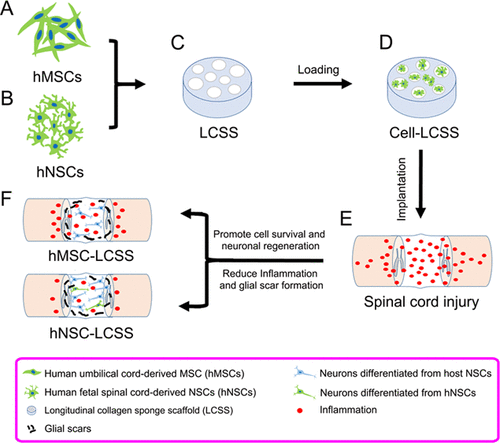当前位置:
X-MOL 学术
›
ACS Biomater. Sci. Eng.
›
论文详情
Our official English website, www.x-mol.net, welcomes your
feedback! (Note: you will need to create a separate account there.)
Comparison of Regenerative Effects of Transplanting Three-Dimensional Longitudinal Scaffold Loaded-Human Mesenchymal Stem Cells and Human Neural Stem Cells on Spinal Cord Completely Transected Rats
ACS Biomaterials Science & Engineering ( IF 5.4 ) Pub Date : 2020-02-19 , DOI: 10.1021/acsbiomaterials.9b01790 Yunlong Zou 1 , Yannan Zhao 2, 3 , Zhifeng Xiao 2 , Bing Chen 2 , Dezun Ma 2 , He Shen 2, 3 , Rui Gu 1 , Jianwu Dai 2, 3
ACS Biomaterials Science & Engineering ( IF 5.4 ) Pub Date : 2020-02-19 , DOI: 10.1021/acsbiomaterials.9b01790 Yunlong Zou 1 , Yannan Zhao 2, 3 , Zhifeng Xiao 2 , Bing Chen 2 , Dezun Ma 2 , He Shen 2, 3 , Rui Gu 1 , Jianwu Dai 2, 3
Affiliation

|
Stem cell-based therapy has been considered as a potential treatment to restore spinal cord injury (SCI) through reconstructing neural networks and providing a favorable microenvironment for neuronal survival, differentiation, and axonal outgrowth. Biomaterial scaffolds can promote cell attachment and survival, neuronal differentiation, and axonal outgrowth; therefore, they were used to combine with stem cells for implantation in SCI treatment. In addition, a longitudinal scaffold can guide regenerated axons with orientated growth and axial extension. Both human umbilical cord-derived mesenchymal stem cells (hMSCs) and human fetal spinal cord-derived neural stem cells (hNSCs) have been applied in clinical trials worldwide. To our knowledge, a parallel comparison of the therapeutic effects of hMSC and hNSC implantations has not been conducted. Hence, in this study, we grafted hMSCs or hNSCs seeded on longitudinal collagen sponge scaffolds into rats with completely transected SCI to examine differences in SCI repair. Both hMSCs and hNSCs had equivalent effects on reducing glial scar formation around the lesion gap. More neuronal class III β-tubulin-positive neurons and neurofilament-positive nerve fibers were found in the lesion cavity after hNSC implantation. In addition, hNSCs had better capabilities to improve motor function, attenuate inflammation, and promote cell survival than hMSCs. These encouraging results provide a clinical basis for future stem cell-based SCI therapies.
中文翻译:

三维纵支架移植人间充质干细胞和人神经干细胞移植对脊髓完全横断大鼠的再生作用比较
基于干细胞的疗法已被认为是通过重建神经网络并为神经元存活,分化和轴突生长提供有利的微环境而恢复脊髓损伤(SCI)的潜在疗法。生物材料支架可以促进细胞附着和存活,神经元分化和轴突生长。因此,它们被用于与干细胞结合用于SCI治疗。另外,纵向支架可以引导再生的轴突定向生长和轴向延伸。人脐带间充质干细胞(hMSCs)和人胎儿脊髓源性神经干细胞(hNSCs)均已在全球范围内进行临床试验。据我们所知,尚未进行hMSC和hNSC植入治疗效果的平行比较。因此,在这项研究中,我们将接种在纵向胶原海绵支架上的hMSCs或hNSCs移植到完全横切SCI的大鼠中,以检查SCI修复的差异。hMSCs和hNSCs在减少病变间隙周围的胶质瘢痕形成方面具有同等作用。hNSC植入后病变腔内发现更多的神经元Ⅲ类β微管蛋白阳性神经元和神经丝阳性神经纤维。此外,与hMSC相比,hNSC具有更好的改善运动功能,减轻炎症和促进细胞存活的能力。这些令人鼓舞的结果为未来基于干细胞的SCI治疗提供了临床基础。hMSCs和hNSCs在减少病变间隙周围的胶质瘢痕形成方面具有同等作用。hNSC植入后病变腔内发现更多的神经元Ⅲ类β微管蛋白阳性神经元和神经丝阳性神经纤维。此外,与hMSC相比,hNSC具有更好的改善运动功能,减轻炎症和促进细胞存活的能力。这些令人鼓舞的结果为未来基于干细胞的SCI治疗提供了临床基础。hMSCs和hNSCs在减少病变间隙周围的胶质瘢痕形成方面具有同等作用。hNSC植入后病变腔内发现更多的神经元Ⅲ类β微管蛋白阳性神经元和神经丝阳性神经纤维。此外,与hMSC相比,hNSC具有更好的改善运动功能,减轻炎症和促进细胞存活的能力。这些令人鼓舞的结果为未来基于干细胞的SCI治疗提供了临床基础。
更新日期:2020-02-20
中文翻译:

三维纵支架移植人间充质干细胞和人神经干细胞移植对脊髓完全横断大鼠的再生作用比较
基于干细胞的疗法已被认为是通过重建神经网络并为神经元存活,分化和轴突生长提供有利的微环境而恢复脊髓损伤(SCI)的潜在疗法。生物材料支架可以促进细胞附着和存活,神经元分化和轴突生长。因此,它们被用于与干细胞结合用于SCI治疗。另外,纵向支架可以引导再生的轴突定向生长和轴向延伸。人脐带间充质干细胞(hMSCs)和人胎儿脊髓源性神经干细胞(hNSCs)均已在全球范围内进行临床试验。据我们所知,尚未进行hMSC和hNSC植入治疗效果的平行比较。因此,在这项研究中,我们将接种在纵向胶原海绵支架上的hMSCs或hNSCs移植到完全横切SCI的大鼠中,以检查SCI修复的差异。hMSCs和hNSCs在减少病变间隙周围的胶质瘢痕形成方面具有同等作用。hNSC植入后病变腔内发现更多的神经元Ⅲ类β微管蛋白阳性神经元和神经丝阳性神经纤维。此外,与hMSC相比,hNSC具有更好的改善运动功能,减轻炎症和促进细胞存活的能力。这些令人鼓舞的结果为未来基于干细胞的SCI治疗提供了临床基础。hMSCs和hNSCs在减少病变间隙周围的胶质瘢痕形成方面具有同等作用。hNSC植入后病变腔内发现更多的神经元Ⅲ类β微管蛋白阳性神经元和神经丝阳性神经纤维。此外,与hMSC相比,hNSC具有更好的改善运动功能,减轻炎症和促进细胞存活的能力。这些令人鼓舞的结果为未来基于干细胞的SCI治疗提供了临床基础。hMSCs和hNSCs在减少病变间隙周围的胶质瘢痕形成方面具有同等作用。hNSC植入后病变腔内发现更多的神经元Ⅲ类β微管蛋白阳性神经元和神经丝阳性神经纤维。此外,与hMSC相比,hNSC具有更好的改善运动功能,减轻炎症和促进细胞存活的能力。这些令人鼓舞的结果为未来基于干细胞的SCI治疗提供了临床基础。











































 京公网安备 11010802027423号
京公网安备 11010802027423号